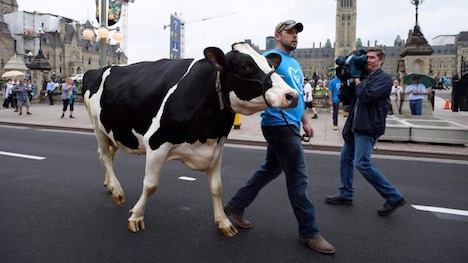Before you take at face value Trump's bellyaching about Canada's dairy industry, you might like to know how it works and why he's full of it
 Print This Print This
By John Paul Tasker | CBC
Canadian Broadcasting Corporation
Monday, Jul 2, 2018
How Canada's supply management system works
It's been blamed for inflating food prices - but a lot of American producers wish they had something like it
 |
| Chris Ryan walks dairy cow Ninja on Wellington Street as dairy farmers protest on Parliament Hill on Thursday, June 2, 2016 in Ottawa. (Justin Tang/Canadian Press) |
Canada's system of supply management has been the target of heated political debate for the better part of half a century — but very few Canadians outside of the affected farm sectors actually understand how it works, or who foots the bill for stabilizing farmers' incomes.
Supply management is a system that allows specific commodity sectors — dairy, poultry and eggs — to limit the supply of their products to what Canadians are expected to consume in order to ensure predictable, stable prices.
While the federal government has played a role in supporting agricultural pricing policies for more than a century, the current system of supply management traces its origins to the 1960s — a period of overproduction due to technological advances that resulted in low prices for farmers.
While the federal government was keen to support farmers' incomes — and the votes that come with them — direct financial supports became too heavy a burden for the federal treasury to bear.
Bruce Muirhead, a historian at the University of Waterloo who has written extensively about supply management, said the government of the day felt that $50-55 million in annual support payments "would seriously upset the balance of the budget."
"This is one of the reasons we moved to a supply-managed system — government wanted to make farming sustainable on its own," Muirhead writes in his research paper 'Crying Over Spilt Milk'.
The United States, in contrast, has largely maintained support for the farming sector through subsidies. So Americans foot the bill for farm supports indirectly, through the taxes they pay, while Canadians pay for those supports directly, through higher prices for supply-managed products.
According to a Library of Parliament study of supply management, the system rests on three pillars: production control, pricing mechanisms and import control.
First pillar: quotas
Under supply management, a national marketing agency determines production amounts for each commodity and then sets production quotas for each province.
In order to sell their products, a farmer must hold a quota — basically a license to produce up to a set amount. The quota prevent market gluts that would cause prices to dip and disrupt farm incomes.
As of 2015, there were just over 16,000 quota holders in Canada — most of them dairy farmers in Ontario and Quebec. The quotas initially were given away for free but quickly became quite valuable; Canada's total quota is now valued at over $32 billion.
Muirhead told CBC News that while U.S. President Donald Trump has pushed Canada to dismantle the system to help U.S. farmers, many dairy farmers south of the border look at Canada's system of supply management with envy.
He said Wisconsin farmers in particular are beset by production issues that have caused prices to tank; the state has more cows than all of Canada and produces more milk.
"Those guys are massively in favour of supply management. It would stabilize their industry," he said.
Second pillar: minimum prices
Supply-managed producers are guaranteed a minimum price for their products. Through provincial marketing boards, farmers negotiate minimum "farm gate prices" with processors.
Critics maintain that Canadians pay too much for supply-managed products because the system inflates prices beyond what an open market would impose in order to keep farmers afloat.
But not everyone agrees — and the research is by no means unanimous in its conclusions.
In 2014, a Nielsen Company study commissioned by the Dairy Farmers of Canada showed that the price of Canadian dairy products compared favourably with prices in other countries.
The Montreal Economic Institute, a centre-right think tank, maintains that millions of Canadians are paying artificially high prices to benefit a few thousand farmers. A recent University of Manitoba study concluded that supply management costs wealthy families an average of $554 a year, with lower income families facing an average bill of more than $339 a year as a result of the policy.
"Supply management hurts all 35 million Canadian consumers by forcing them to pay consistently more for milk, chicken and eggs, as well as for other products that use these foodstuffs as ingredients," the institute wrote in a recent report on the matter. "Importantly, supply management disproportionately hurts poor Canadians."
Former Conservative leadership candidate Maxime Bernier, who nearly bested Andrew Scheer in the party's leadership contest last year, has become one of the country's most vocal opponents of supply management.
 |
| Maxime Bernier watches during the Conservative Party of Canada leadership convention in Toronto, Ont., on May 27, 2017. (Mark Blinch/Reuters) |
"The worst aspect of supply management, however, isn't that all Canadians who buy these products must pay more. It's that the poor, and households with children, are affected the most," Bernier wrote in a chapter from his forthcoming book.
"It should be clear that this is a transfer of wealth from the poorest to some of the richest in our society. Farming families working under supply management are indeed far richer than most Canadian families. Average after-tax income of all households in Canada is $69,100. By comparison, the average dairy farming household income is $147,800, and the number is $180,400 for poultry-farming households."
But dairy farmers point to retail prices for milk in jurisdictions that have deregulated their dairy industries, like the United Kingdom and Australia, as proof that supply management strikes the right balance.
In Australia, for example, prices for milk in the major cities rose 27 cents per litre in the three years after deregulation.
In New Zealand, the largest dairy exporting country in the world, milk prices are higher than they are here in Canada.
Third pillar: high tariffs
The third pillar of supply management is the imposition of high tariffs on foreign imports, a policy that makes these goods prohibitively expensive for Canadians, leaving domestic supply as virtually the only option for consumers.
It's this policy in particular that annoys Trump, who has said the policy is unfair to American farmers.
In fact, the main source of the financial problems plaguing some U.S. dairy operations is overproduction.
Canada sets tariff-rate quotas, meaning some foreign goods — about 10 per cent of Canada's domestic dairy market, for example — enter tariff-free, but all other imports face high tariffs to prevent foreign foods from flooding into the country.
In comparison, the United States gives foreign dairy products access to only 2.75 per cent of its domestic market. Europe offers just 0.5 per cent access for foreign poultry.
Source URL
|
 Print This Print This

|

